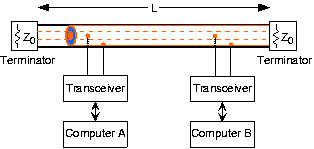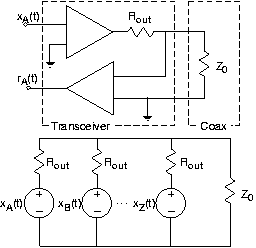| << Chapter < Page | Chapter >> Page > |

Ethernet uses as its communication medium a single length of coaxial cable ( [link] ). This cable serves as the "ether", through which all digital datatravel. Electrically, computers interface to the coaxial cable ( [link] ) through a device known as a transceiver . This device is capable of monitoring the voltage appearing between the core conductor andthe shield as well as applying a voltage to it. Conceptually it consists of two op-amps, one applying a voltage corresponding toa bit stream (transmitting data) and another serving as an amplifier of Ethernet voltage signals (receiving data). Thesignal set for Ethernet resembles that shown in BPSK Signal Sets , with one signal the negative of the other. Computers are attached in parallel, resulting in thecircuit model for Ethernet shown in [link] .
From the viewpoint of a transceiver's sending op-amp, what is the load it sees and what is the transfer functionbetween this output voltage and some other transceiver's receiving circuit? Why should the output resistor be large?
The transmitting op-amp sees a load or , where is the number of transceivers other than this one attached to thecoaxial cable. The transfer function to some other transceiver's receiver circuit is divided by this load.

No one computer has more authority than any other to control when and how messages are sent. Without scheduling authority,you might well wonder how one computer sends to another without the (large) interference that the other computers would produceif they transmitted at the same time. The innovation of Ethernet is that computers schedule themselves by a random-access method. This method relies on the fact that all packets transmitted over the coaxial cable can be received by all transceivers, regardless of which computer might actually be the intended recipient. In communications terminology, Ethernetdirectly supports broadcast. Each computer goes through the following steps to send a packet.
The reason two computers waiting to transmit may not sense the other's transmission immediately arises because of the finitepropagation speed of voltage signals through the coaxial cable. The longest time any computer must wait to determine ifits transmissions do not encounter interference is , where is the coaxial cable's length. The maximum-length-specification for Ethernet is1 km. Assuming a propagation speed of 2/3 the speed of light, this time interval is more than 10 μs. As analyzed in Problem 22 , the number of these time intervals required to resolve the collision is, on the average, less than two!
Why does the factor of two enter into this equation? (Consider the worst-case situation of two transmittingcomputers located at the Ethernet's ends.)
The worst-case situation occurs when one computer begins to transmit just before the other's packetarrives. Transmitters must sense a collision before packet transmission ends. The time taken for one computer's packetto travel the Ethernet's length and for the other computer's transmission to arrive equals theround-trip, not one-way, propagation time.
Thus, despite not having separate communication paths among the computers to coordinate their transmissions, the Ethernet randomaccess protocol allows computers to communicate without only a slight degradation in efficiency, as measured by the time takento resolve collisions relative to the time the Ethernet is used to transmit information.
A subtle consideration in Ethernet is the minimum packet size . The time required to transmit such packets equals , where is the Ethernet's capacity in bps. Ethernet now comes in two differenttypes, each with individual specifications, the most distinguishing of which is capacity: 10 Mbps and 100 Mbps. Ifthe minimum transmission time is such that the beginning of the packet has not propagated the full length of the Ethernet beforethe end-of-transmission, it is possible that two computers will begin transmission at the same time and, by the time theirtransmissions cease, the other's packet will not have propagated to the other. In this case, computers in-between the two willsense a collision, which renders both computer's transmissions senseless to them, without the two transmitting computersknowing a collision has occurred at all! For Ethernet to succeed, we must have the minimum packet transmission timeexceed twice the voltage propagation time: or
The 100 Mbps Ethernet was designed more recently than the 10 Mbps alternative. To maintain the same minimum packet sizeas the earlier, slower version, what should its length specification be? Why should the minimum packet size remainthe same?
The cable must be a factor of ten shorter: It cannot exceed 100 m. Different minimum packet sizes means differentpacket formats, making connecting old and new systems together more complex than need be.

Notification Switch
Would you like to follow the 'Fundamentals of electrical engineering i' conversation and receive update notifications?